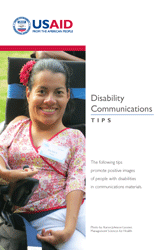- What We Do
- Agriculture and Food Security
- Democracy, Human Rights and Governance
- Democracy, Human Rights and Governance Strategy
- Supporting Free and Fair Elections
- Supporting Vibrant Civil Society & Independent Media
- Protecting Human Rights
- Promoting Accountability & Transparency
- Importance of Democracy, Human Rights, & Governance to Development
- COVID-19: Issues and Potential USAID Responses
- Countering Trafficking in Persons
- Global Labor Program
- Religious Freedom
- Youth Impact
- Economic Growth and Trade
- Education
- Environment and Global Climate Change
- Gender Equality and Women's Empowerment
- Global Health
- Humanitarian Assistance
- Transformation at USAID
- Water and Sanitation
- Working in Crises and Conflict
- U.S. Global Development Lab
Speeches Shim
A Global Look at Disability
Over 1 billion people, or approximately 15 percent of the world’s population, live with some form of disability. Eighty percent of them live in developing countries.
Due to population ageing and an increase in chronic health conditions, those numbers are expected to increase.
Success Story

PUBLICATION: With USAID's help, Karen Cano, a young woman with Down syndrome living in the noisy outskirts of Paraguay's capital city of Asuncion, is embracing new opportunities to reach her dreams. View the photo story.
Highlights
Disability Communication Tips ![]() (pdf - 781k)
(pdf - 781k)
PUBLICATION: Equal Access: How to Include Persons with Disabilities in Elections and Political Processes (PDF, 3.24MB) provides practical tips on including persons with disabilities throughout the electoral cycle.
E-LEARNING: Disability Inclusive Development 101 gives a snapshot of disability and its critical implications for international development.
With sign language interpretation and captions (fast connections)
With captions only (slower connections)
Persons with disabilities are more likely to experience poverty. They are also less likely to access basic services because of stigma, discrimination and inaccessibility. The lack of access to vital services and programs contributes to their marginalization and exclusion, with little or no option to escape from poverty.
Societies that are inclusive of their diverse populations are more likely to be democratic, participatory and equitable. They are more likely to meet their development goals.
In spite of this, and although disability is a cross-cutting development issue, persons with disabilities remain invisible in the global development agenda.
USAID’s Development Approach
USAID is committed to disability-inclusive development. Our approach is twin tracked:
- We support disability-specific programs to address targeted needs; and
- We seek to integrate disability into all our programs.
Why? Because we have legal, social and economic reasons to include persons with disabilities into all our programming, including:
- Discrimination on the grounds of disability is illegal in many countries including in the US.
- Disability rights are human rights; and
- Excluding persons with disabilities results in economic losses for the country where they live and for the global economy.
Sectors of Disability-Focused Work
USAID is working across several fields to further the human rights of people with disabilities including:
- Education
- Inclusion in political processes
- Economic empowerment
- Job training
- Improving design of health and emergency services
Across these fields, our programs seek to:
- Improve the quality and accessibility of education for students with disabilities through the promotion of sign language, Braille, assistive technology and other inclusive education practices.
- Increase the participation of people with disabilities in political processes through national awareness campaigns, use of accessible polling stations and voter materials and open exchange between disability communities and politicians to rewrite election laws to be more inclusive and compliant with the UN Convention on the Rights of People with Disabilities.
- Strengthen organizations run by and for people with disabilities to advocate on their own behalf, design and implement development programs and access direct funding.
- Support the economic independence of women with disabilities through microcredit programs that provide seed grants to women to invest in their families and start new businesses.
- Integrate youth and adults with disabilities into the competitive workforce by facilitating job training, internship opportunities and educating employers on best practices for hiring people with disabilities.
- Ensure community health care providers and disaster response experts include people with disabilities in their programs by employing the principles of universal design.


Comment
Make a general inquiry or suggest an improvement.